Protectorate of Bohemia and Moravia
| Protectorate of Bohemia and Moravia | ||||||||||
| Protektorat Böhmen und Mähren Protektorát Čechy a Morava | ||||||||||
| Autonomous Protectorate of Germany[1] | ||||||||||
| ||||||||||
| ||||||||||
| Anthem Kde domov můj? / Wo ist mein Heim? "Where is my home?" | ||||||||||
.svg.png) The Protectorate of Bohemia and Moravia in 1942. | ||||||||||
| Capital | Prague | |||||||||
| Languages | Czech, German | |||||||||
| Political structure | Autonomous Protectorate | |||||||||
| Reich Protector | ||||||||||
| • | 1939–1943 | Konstantin von Neurath | ||||||||
| • | 1941–1942 | Reinhard Heydrich (acting) | ||||||||
| • | 1942–1943 | Kurt Daluege (acting) | ||||||||
| • | 1943–1945 | Wilhelm Frick | ||||||||
| State President | ||||||||||
| • | 1939–1945 | Emil Hácha | ||||||||
| Prime Minister | ||||||||||
| • | 1939 | Rudolf Beran (acting) | ||||||||
| • | 1939–1941 | Alois Eliáš | ||||||||
| • | 1942–1945 | Jaroslav Krejčí | ||||||||
| • | 1945 | Richard Bienert | ||||||||
| Historical era | World War II | |||||||||
| • | German occupation | 15 March 1939 | ||||||||
| • | Liberation of Prague | 11 May 1945 | ||||||||
| Area | ||||||||||
| • | 1939 | 49,363 km² (19,059 sq mi) | ||||||||
| Population | ||||||||||
| • | 1939 est. | 7,380,000 | ||||||||
| Density | 149.5 /km² (387.2 /sq mi) | |||||||||
| Currency | Protectorate Koruna | |||||||||
| ||||||||||
| Today part of | | |||||||||
The Protectorate of Bohemia and Moravia (German: Protektorat Böhmen und Mähren; Czech: Protektorát Čechy a Morava) was the majority ethnic-Czech protectorate of Nazi Germany established following the German occupation of Czechoslovakia by annexing Sudetenland territory of Czech Lands as a Reichsgau. Following the establishment of the independent Slovak Republic on 14 March 1939, and the German occupation of the Czech rump state the next day, the protectorate was established on 16 March 1939 by a proclamation of Adolf Hitler from Prague Castle.
The German government justified its intervention by claiming that Czechoslovakia was descending into chaos as the country was breaking apart on ethnic lines, and that the German military was seeking to restore order in the region.[2] Czechoslovakia at the time under President Emil Hácha had pursued a pro-German foreign policy; however, upon meeting with German Führer Adolf Hitler, Hácha submitted to Germany's demands and issued a declaration stating that in light of events he accepted that the fate of the Czech people would be decided by Germany; Hitler accepted Hácha's declaration and declared that Germany would provide the Czech people with an autonomous protectorate governed by ethnic Czechs.[2] Hácha was appointed president of the protectorate the same day.
The Protectorate was an autonomous Nazi-administered territory which the German government considered part of the Greater German Reich.[1] The state's existence came to an end with the surrender of Germany to the Allies in 1945.
History
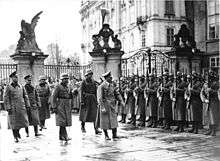
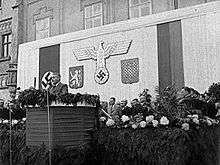
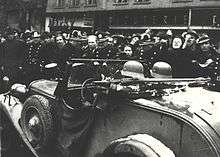
On 10 October 1938, when Czechoslovakia felt obliged to accept the terms of the Munich Agreement, Germany incorporated the Sudetenland - located on the Czechoslovak border with Germany and Austria proper, with its majority of ethnic German inhabitants - directly into the Reich. Five months later, when the Slovak Diet declared the independence of Slovakia, Hitler summoned Czechoslovak President Emil Hácha to Berlin and intimidated him into accepting the German occupation of the Czech rump state and its reorganisation as a German protectorate.
Hácha remained as technical head of state with the title of State President, but Germany rendered him all but powerless, vesting real power in the Reichsprotektor, who served as Hitler's personal representative. To appease outraged international opinion, Hitler appointed former foreign minister Konstantin von Neurath to the post. German officials manned departments analogous to cabinet ministries, while small German control offices were established locally. The SS assumed police authority; Reichsführer-SS and Reich police chief Heinrich Himmler named the former Sudeten German leader Karl Hermann Frank as the protectorate's police chief and ranking SS officer. The new authorities dismissed Jews from the civil service and placed them outside of the legal system. Political parties and trade unions were banned, and the press and radio were subjected to harsh censorship. Many local Communist Party leaders fled to the Soviet Union.
The population of the protectorate was mobilized for labor that would aid the German war effort, and special offices were organized to supervise the management of industries important to that effort. The Germans drafted Czechs to work in coal mines, in the iron and steel industry, and in armaments production; some young people were sent to Germany. Consumer-goods production, much diminished, was largely directed toward supplying the German armed forces. The protectorate's population was subjected to strict rationing.
First issue of currency in Protectorate of Bohemia and Moravia (an unissued 1938 Czech note with a validation stamp for use in 1939).
German rule was moderate—at least by Nazi standards—during the first months of the occupation. The Czech government and political system, reorganized by Hácha, continued in formal existence. The Gestapo directed its activities mainly against Czech politicians and the intelligentsia. The eventual goal of the German state under Nazi leadership was to eradicate Czech nationality through assimilation and deportation, and the extermination of the Czech intelligentsia; the intellectual ėlites and members of the middle class made up a considerable number of the 200,000 people who passed through concentration camps and of the 250,000 who died during the German occupation.[3] In 1940, in a secret plan on the Germanization of the Protectorate of Bohemia and Moravia it was declared that those considered to be racially Mongoloid and the Czech intelligentsia were not to be Germanized and about half of the Czech population were suitable for Germanization.[4] Generalplan Ost assumed that around 50% of Czechs would be fit for Germanization. The Czech intellectual élites were to be removed not only from Czech territories but from Europe completely. The authors of Generalplan Ost believed it would be best if they emigrated overseas, as even in Siberia they were considered a threat to German rule. Just like Jews, Poles, Serbs, and several other nations, Czechs were considered to be untermenschen by the Nazi state.[5]
The Czechs demonstrated against the occupation on 28 October 1939, the 21st anniversary of Czechoslovak independence. The death on 15 November 1939 of a medical student, Jan Opletal, who had been wounded in the October violence, precipitated widespread student demonstrations, and the Reich retaliated. Politicians were arrested en masse, as were an estimated 1,800 students and teachers. On 17 November all universities and colleges in the protectorate were closed, nine student leaders were executed, and 1,200 were sent to the concentration camp in Sachsenhausen within Nazi Germany; further arrests and executions of Czech students and professors took place later during the occupation.[6] (See also Czech resistance to Nazi occupation)
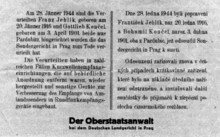
During World War II, Hitler decided that Neurath wasn't treating the Czechs harshly enough and adopted a more radical policy in the protectorate. On 29 September 1941, Hitler appointed SS hardliner Reinhard Heydrich as Deputy Reichsprotektor. At the same time Neurath was relieved of his day-to-day duties, so for all intents and purposes Heydrich replaced Neurath as Reichsprotektor. Under Heydrich's authority Prime Minister Alois Eliáš was arrested (and later executed), the Czech government was reorganized, and all Czech cultural organizations were closed. The Gestapo indulged in arrests and executions. The deportation of Jews to concentration camps was organized, and the fortress town of Terezín was made into a ghetto way-station for Jewish families. On 4 June 1942, Heydrich died after being wounded by an assassin in Operation Anthropoid. Directives issued by Heydrich's successor, SS-Oberstgruppenführer Kurt Daluege, ordered mass arrests, executions and the obliteration of the villages of Lidice and Ležáky. In 1943 the German war-effort was accelerated. Under the authority of Karl Hermann Frank, German minister of state for Bohemia and Moravia, some 400,000 Czechs were used as forced labor by the German Reich.[7] Within the protectorate, all non-war-related industry was prohibited. Most of the Czech population obeyed quietly up until the final months preceding the end of the war, when thousands became involved in the resistance movement.
For the Czechs of the Protectorate Bohemia and Moravia, German occupation represented a period of brutal oppression. Czech losses resulting from political persecution and deaths in concentration camps totalled between 36,000 and 55,000.[8] The Jewish population of Bohemia and Moravia (118,000 according to the 1930 census) was virtually annihilated, with over 75,000 murdered.[9] Of the 92,199 people classified as Jews by German authorities in the Protectorate as of 1939, 78,154 perished in Holocaust, or 84.8 percent.[10]
Many Jews emigrated after 1939; 8,000 survived at Terezín concentration camp (which was used for propaganda purposes as a showpiece).[9] Several thousand Jews managed to live in freedom or in hiding throughout the occupation. The extermination of the Romani population was so thorough that the Bohemian Romani language became totally extinct. Romani internees were sent to the Lety and Hodonín concentration camps before being transferred to Auschwitz-Birkenau for gassing. The vast majority of Romani in the Czech Republic today descend from migrants from Slovakia who moved there within post-war Czechoslovakia. The Theresienstadt concentration camp was located in the Protectorate, near the border to the Reichsgau Sudetenland. It was designed to concentrate the Jewish population from the Protectorate and gradually move them to extermination camps and also held Western European and German Jews. While not an extermination camp itself the harsh and unhygienic conditions still resulted in the death of 33,000 of the 140,000 Jews brought to the camp while a further 88,000 were send to extermination camps and only 19,000 survived.[11]
Politics
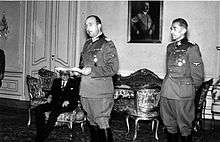
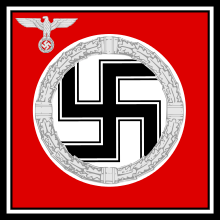
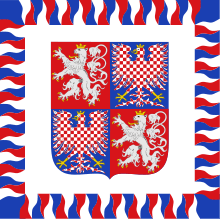
After the establishment of the Protectorate all political parties were outlawed, with the exception of the National Union (Národní souručenství). This local Czech Fascist party was led by a ruling Presidium until 1942, after which a Vůdce (Leader) for the party was appointed.
German government
Ultimate authority within the Protectorate was held by the Reich Protector (Reichsprotektor), the area's senior Nazi administrator, whose task it was to represent the interests of the German state. The office and title were held by a variety of persons during the Protectorate's existence. In succession these were:
- 16 March 1939 – 20 August 1943:
Konstantin von Neurath, former Foreign Minister of Nazi Germany, Minister without Portfolio until 1943. He was removed from office after Hitler's dissatisfaction with his "soft policies" in 1941, although he still held the title until his official resignation in 1943.
- 27 September 1941 – 30 May 1942:
Reinhard Heydrich, chief of the SS-Reichssicherheitshauptamt (Reich Main Security Office) or RSHA. He was officially only a deputy to Neurath, but in reality was granted supreme authority over the entire state apparatus of the Protectorate.
- 31 May 1942 – 20 August 1943:
Kurt Daluege, Chief of the Ordnungspolizei (Order Police) or Orpo, in the Interior Ministry, who was also officially a deputy Reich Protector.
- 20 August 1943 – 5 May 1945:
Wilhelm Frick, former Minister of the Interior.
Next to the Reich Protector there was also a political office of State Secretary (from 1943 known as the State Minister to the Reich Protector) who handled most of the internal security. From 1939 to 1945 this person was Karl Hermann Frank the senior SS and Police Leader in the Protectorate. A paper command of the Allgemeine-SS, with no operational authority, was also established known as the SS-Oberabschnitt Böhmen-Mähren.
Czech government
.jpg)
The Czech State President (Státní Prezident) under the period of German rule from 1939 to 1945 was Emil Hácha (1872–1945), who had been the President of the Second Czechoslovak Republic since November 1938. Rudolf Beran (1887–1954) continued to hold the office of Minister President (Předseda vlády) after the German take-over. He was replaced by Alois Eliáš on 27 April 1939, who was himself also sacked on 2 October 1941 not long after the appointment of Reinhard Heydrich as the new Reich Protector. Because of his contacts with the Czechoslovak Government-in-Exile Eliáš was sentenced to death, and the execution was carried out on 19 June 1942 shortly after Heydrich's own death. From 19 January 1942 the government was led by Jaroslav Krejčí, and from January to May 1945 by Richard Bienert, the former police chief of Prague. When the dissolution of the Protectorate was proclaimed after the Liberation of Prague, a radio call was issued for Bienert's arrest. This resulted in his conviction to a three-year prison term in 1947, during which he died in 1949.
Aside from the Office of the Minister President, the local Czech government in the Protectorate consisted of the Ministries of Education, Finance, Justice, Trade, the Interior, Agriculture, and Public Labour. The area's foreign policy and military defence were under the exclusive control of the German government. The former foreign minister of Czechoslovakia František Chvalkovský became a Minister without Portfolio and permanent representative of the Czech administration in Berlin.
The most prominent Czech politicians in the Protectorate included:
- Alois Eliáš (1890–1942), a former Czechoslovak General who was executed for his secret contacts with the Czechoslovak Government-in-Exile in 1942; Prime Minister from 1939 to 1941.
- Ladislav Karel Feierabend, Minister of Agriculture from 1939 to 1940. Joined the London-based Czechoslovak government in 1940.
- Jiří Havelka, Minister of Traffic from 1939 to 1941.
- Josef Ježek, Interior Minister from 1939 to 1942.
- Jan Kapras, Minister of Education from 1939 to 1942.
- Josef Kalfus (1880–1956), Minister of Finance from 1939 to 1945.
- Josef Nebeský, party leader of the National Union from 1939 to 1941.
- Josef Fousek (1875–1942), party leader of the National Union from 1941 to 1942.
- Jaroslav Krejčí (1892–1956), Minister of Justice from 1939 to 1945, as well as Minister President from 1942 to 1945.
- Jindřich Kamenický, Minister of Traffic from 1941 to 1945.
- Walter Bertsch, Minister of Economics from 1942 to 1945.
- Richard Bienert (1881–1949), Interior Minister from 1942 to 1945, as well as the last Minister President in 1945.
- Adolf Hrubý (1893–1951), Minister of Agriculture from 1942 to 1945.
- Tomáš Krejčí, Führer (Vůdce) of the National Union from 1942 to 1945.
- Emanuel Moravec, Minister of Education from 1942 to 1945.
Population
The area of the Protectorate of Bohemia and Moravia contained about 7,380,000 inhabitants in 1940. 225,000 (3.3%) of these were of German origin, while the rest were mainly ethnic Czechs as well as some Slovaks, particularly near the border with Slovakia.
The protectorate was projected to become fully Germanized. Hitler had approved a plan designed by Konstantin von Neurath and Karl Hermann Frank, which projected the Germanization of the "racially valuable" half of the Czech population after the end of the war.[12] This consisted mainly of industrial workers and farmers.[12] The undesirable half contained also the intelligentsia, whom the Nazis viewed as ungermanizable and potential dangerous instigators of Czech nationalism. Some 9,000 Volksdeutsche from Bukovina, Dobruja, South Tyrol, Bessarabia, Sudetenland and the Altreich were settled in the protectorate during the war.[12] The goal was to create a German settlement belt from Prague to Sudetenland, and to turn the surroundings of Olomouc (Olmütz), České Budějovice (Budweis), Brno (Brünn) and the area near the Slovak border into German enclaves.[12]
Further integration of the protectorate into the Reich was carried out by the employment of German apprentices, by transferring German evacuee children into schools located in the protectorate, and by authorizing marriages between Germans and "assimilable" Czechs.[12] Germanizable Czechs were allowed to join the Reich Labour Service and to be admitted to German universities.[12]
Peoples' reaction was humor, sarcasm and satire, so Germans called Czech citizens as "laughing beasts".
Administrative subdivisions
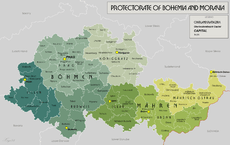
Protectorate districts
For administrative purposes the Protectorate of Bohemia and Moravia was divided into two Lands; Böhmen (Bohemia) and Mähren (Moravia). Each of these was further subdivided into Oberlandratsbezirke, each comprising a number of Bezirke.
NSDAP districts
For party administrative purposes the Nazi Party extended its Gau-system to Bohemia and Moravia when the Protectorate was established. This step divided the remaining parts of Bohemia and Moravia up between its four surrounding Gaue:
- Sudetenland;
- Bayreuth (Bavarian Eastern March);
- Lower Danube;
- Upper Danube.
The resulting government overlap led to the usual authority conflicts typical of the Third Reich era. Seeking to extend their own powerbase and to facilitate the area's Germanization the Gauleiters of the surrounding districts continually agitated for the liquidation of the Protectorate and its direct incorporation into the German Reich. Hitler stated as late as 1943 that the issue was still to be decisively settled.[13]
Stamps, currency, officials and documents
 A bill of 50 Crowns of the Protectorate.
A bill of 50 Crowns of the Protectorate.- 1 Crown or Koruna of the Protectorate.
 Stamp of the Protectorate.
Stamp of the Protectorate. Alois Eliáš, first prime minister of the Protectorate, 1939–1941. Executed in 1942
Alois Eliáš, first prime minister of the Protectorate, 1939–1941. Executed in 1942 Personal identification card of the Protectorate.
Personal identification card of the Protectorate.

See also
- List of rulers of the Protectorate Bohemia and Moravia
- German occupation of Czechoslovakia
- Prague Offensive
- Resttschechei
- History of Slovakia
- Concentration camps Lety and Hodonín
- Out Distance
- Slovak Republic (1939-1945)
References
- 1 2 Lemkin, Raphaël: Axis Rule in Occupied Europe, page 343. Harold Bold Verlag, 1944.
- 1 2 Crowhurst, Patrick. Hitler and Czechoslovakia in World War II: Domination and Retaliation. P96.
- ↑ Universities in the nineteenth and early twentieth centuries (1800–1945)Walter Rüegg Cambridge University Press (28 October 2004) page 353
- ↑ "Nazi Conspiracy & Aggression Volume I Chapter XIII Germanization & Spoliation Czechoslovakia".
- ↑ HITLER'S PLANS FOR EASTERN EUROPE Selections from Janusz Gumkowski and Kazimierz Leszczynski POLAND UNDER NAZI OCCUPATION at the Wayback Machine (archived 5 December 2012)
- ↑ Universities under dictatorship, page 168, John Connelly, Michael Grüttner, Penn State Press, 2005
- ↑ Fawn, Rick, and Jiří Hochman (2010). Historical dictionary of the Czech State. 2nd ed. Lanham, Maryland: The Scarecrow Press. p. 288.
- ↑ The Czechs and the lands of the Bohemian crown, page 215 Hugh LeCaine Agnew
- 1 2 The Czechs and the lands of the Bohemian crown, page 215
- ↑ Fawn, Rick, and Jiří Hochman (2010). Historical dictionary of the Czech State. 2nd ed. Lanham, Maryland: The Scarecrow Press. p. 128.
- ↑ "Theresienstadt" (PDF). yadvashem.org. Yad Vashem. Retrieved 13 April 2016.
- 1 2 3 4 5 6 Kroener, Bernhard R.; Müller, Rolf-Dieter; Umbreit, Hans (2003). Germany and the Second World War:Organization and mobilization of the German sphere of power. Wartime administration, economy, and manpower resources 1942-1944/5. Oxford University Press. p. 255. ISBN 0-19-820873-1.
- ↑ Teigh, Mikulas: Bohemia in History, page 274. Cambridge University Press, 1998.
Sources
| Wikimedia Commons has media related to Protectorate of Bohemia and Moravia. |
- WorldStatesmen – Czech Republic
- Westermann, Großer Atlas zur Weltgeschichte (German)
External links
- Maps of the Protectorate Bohemia and Moravia
- Amtliches Deutsches Ortsbuch für das Protektorat Böhmen und Mähren
- Map at the Wayback Machine (archived 7 October 2012)
- Hungarian language map, with land transfers by Germany, Hungary, and Poland in the late 1930s.
- Maps of Europe showing the breakup of Czechoslovakia and the creation of the Protectorate of Bohemia and Moravia at omniatlas.com
- State Secretary in the Reich Protector of Bohemia and Moravia 1939 - 1945
- German State Ministry of Bohemia and Moravia 1939 - 1945
Coordinates: 50°05′00″N 14°28′00″E / 50.0833°N 14.4667°E

.svg.png)
ND.jpg)
.svg.png)


.svg.png)